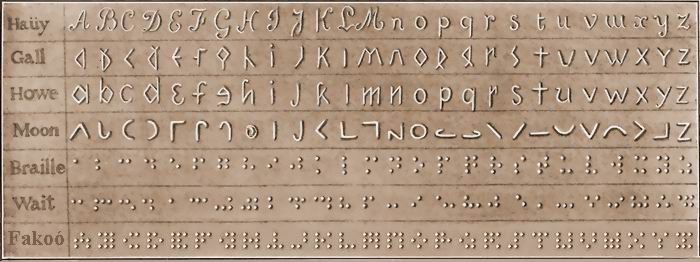old and new writings for the blind
development of writings for the blind earlier and today::
- Classification of writings for the blind in dot writings and relief writings:
Even if the other writing systems are not as important, the general equation of Braille writing with the dot writing or writing for the blind is incorrect. The writing by Braille is the most effective writing system for the blind and it is successful, but it is not suitable for all blind people nor used by all blind people.


-
Before the triumphal of the dot writing system, for example, raised letters by Valentin Haüy
were used which were much too complicated to be read in rapid succession. For the relief writing by Haüy,
used since 1784, characters are written by using an iron pen to scratch the characters backwards into thick paper.
Other relief writing systems developed by Terzi, Alston, Gall, Howe, Lucas, Hebold, Frere and so on. (external links look timetable of writings for the blind)
-
The Sting Writing system, invented by the German Johann Wilhelm Klein in 1807, was also just
as hard to read, although the Latin letters are displayed as dots. It was difficult to read because
the entire letter had to be felt by the fingertip by touching it with upward and downward movements
before the letter could be recognized.
-
The first true dot writing system was invented in 1815 by Charles Barbier. The characters of his Night Writing,
developed for military purposes, consisted of up to 12 dots in two rows. Barbier also brought his
writing system to the Paris Institute of the Blind, where it was also temporarily used as a
writing system for the blind.
-
Between 1821 and 1825 Louis Braille developed his alphabet for the blind
after improving the Night Writing of Charles Barbier. Braille did so by reducing
the number of points to 6. As a result, his dot writing was much easier to read and write. The first
publication of his dot writing system was in 1829, but it took many years before this writing system
prevails. Only in 1850 was the Braille writing system officially recognized as a
writing system for the blind, and thereafter it prevails internationally.
-
In 1839 Louis Braille introduce his Raphigraphy to the replica of the print.
With this writing the blind could write their relatives, the Braille could not read. Later it was
written with an apparatus, and increasingly they writing replaced by the typewriter.
-
Parallel also incurred other writings for the blind, including in 1845 the Moon Alphabet by
William Moon,
which despite the simplicity of optical is still not easy tactile to grasp. Moon developed
the system by Frere continues. (Frere had with similar characters like Lucas, a phonetic
alphabet developed.) The Moon Writing it in some regions of the world
still used as default writing for the blind.
-
From 1871 to 1916 was in New York used the dot writing system dissenting of Braille Writing named "New York Point" The about 1860 by William Bell Wait invented characters
were just two dots high. But despite uppercase and lowercase letters, numbers and punctuation marks was init,
the characters was harder to read than Braille because the length of characters was different. And in 1916 by the
War of the dots was this writing by the English Braille displaced.
-
Even by Joel W. Smith 1878 reformed version named "American Braille"
was in this dispute does not prevail, even though they were arbitrarily set of dot patterns by Braille replaced
for the assignment by a statistically more effective (most letters were the fewest dots). A uniform blind
writing in english-speaking area had priority and it also supported the international dissemination of
Braille Writing.
- Dr. Don Aniceto Mascaró from Lisbon tried around 1900 to combine a dot writing with normal Letters. His Mascaro Alphabet was not practical.
-
With the introduction of computers in the 1980s, the Braille system was expanded to 8 dots so that each character of the computer corresponded
to exactly one braille sign. With this
 Computerbraille
now a total of
Computerbraille
now a total of 2 high 8 = 256 different characterswere possible. The character assignment to 8-point Braille was defined as Eurobraille.
-
In continuation of the idea of Louis Braille for his Raphigrafie for better communication of blind
and seeing was from 2007 to 2008 an alternate dot writing namend "Fakoo" by Alexander Fakoó developed. Fakoo
uses the same dots as the Braille Writing.
Each characters consists of up to 9 dots and an integrated letter distance (9-dots-alphabet, 9-dot-braille, nine-dot braille). Thus this dot writing
is readable also for seeing, why many advantages result.
-
For handwritten recordings for the blinds was developed by Alexander Fakoó
a writing for the blind by hand without curves, which uses only the 4 side-lines and the two diagonals of a square (6-lines-alphabet).
This square writing can be written more simply than Moon and contains apart from letters also numbers.
Since Quadoo is strongly ajar against the print, a big recognizing effect develops.
-
For the universal use, the confusion-free 7-segment alphabet Siekoo
was developed too by Alexander Fakoó in 2012, which also uses only the 7 elements of 7-segment displays for all letters.
-
In 2016 Stefan Stoynov (Bulgaria) developed the Rila alphabet.
An important advantage of his system is that the characters can be used not only for the Latin,
but also for the Greek and Cyrillic alphabet.
-
In New York, the ELIA Idea Team has been developing the Elia Alphabet since 2017,
which is to be used for people with visual impairments.
 View and print the Chronological development of the writings for the blind
View and print the Chronological development of the writings for the blind
some writings for the blind in comparison

Would be to note that the letters of the Braille almost no discernible lateral distance row will be.






















